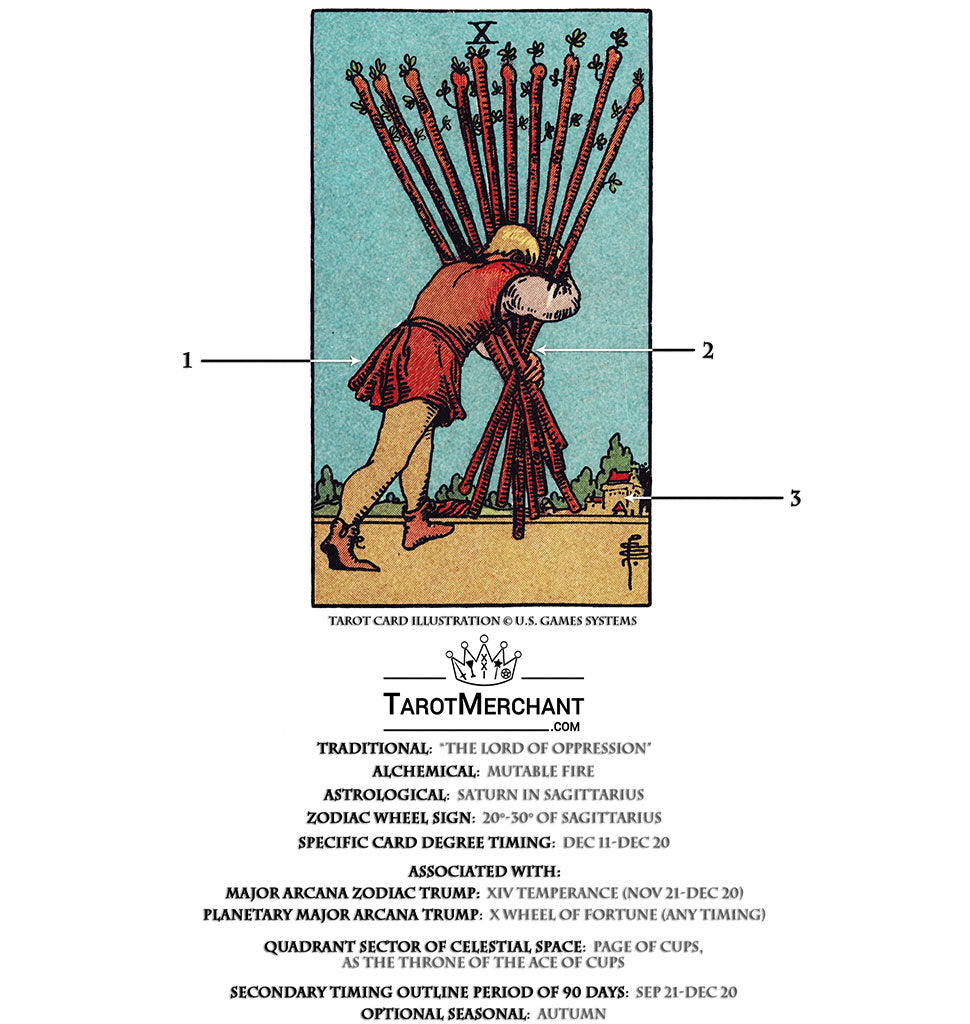The Ten of Wands, an evocative card in the Tarot deck, portrays the burdensome weight of responsibilities and challenges. Illustrated with a figure struggling under the oppressive load of ten heavy wands, this card reflects both the physical and emotional toll that excessive obligations can impose on an individual. It captures a potent metaphor for the human experience: the tendency to take on too much and the inevitable consequences that arise from such endeavors.
This card often symbolizes toil and labor, depicting not merely the act of working hard but also the strains that accompany persistent efforts. The figure in the illustration is bent over, indicating both physical fatigue and a mental overload. At first glance, one might see a mere depiction of struggle; however, a deeper exploration reveals the nuanced layers of meaning that the Ten of Wands encompasses.
First, consider the notion of burdens. The wands themselves represent action, creativity, and ambition. When they accumulate, they can transform into a heavy shroud, stifling one’s vitality and stalling progress. The Ten of Wands asks us to examine the responsibilities we carry. Have we overcommitted ourselves in the relentless pursuit of achievement? This card magnifies the dichotomy between ambition and overwhelm, inviting introspection on the sacrifices made along the path to success.
An essential theme that emerges from the refracted light of the Ten of Wands is that of perseverance. While the figure appears beleaguered, there is also an indication of determination. This duality illustrates that hardships often accompany growth. One can infer that resilience is more deeply cultivated during turbulent times. Just as a tree’s roots strengthen as they push through rocky earth, so too does one’s character deepen under the weight of adversity.
As the story unfolds, the Ten of Wands can also be seen as a harbinger of completion. The number ten symbolically represents the conclusion of a cycle, a summation of experiences. The card implores one to ask whether it is time to shift perspective or to let go of ancestral patterns of overexertion. By acknowledging the weight of one’s burdens, an opportunity for liberation can emerge; identifying what no longer serves one’s trajectory is paramount in the journey forward.
One might ponder the concept of delegation and support as encapsulated by the Ten of Wands. Shouldering the responsibilities alone can lead to isolation and burnout. The imagery of the card nudges practitioners to seek assistance and to share the load. In the richness of collaboration, burdens can become lighter, and entirely new avenues for creativity and expression can reveal themselves. This notion resonates deeply in today’s society, where the glorification of busyness often leads individuals to forsake community for solitary exertion.
Exploring the emotional resonance of the Ten of Wands further, the card evokes feelings of stress and anxiety that come with unrelenting duties. The weight of expectation—either self-imposed or derived from external sources—can lead to a profound existential questioning. What is the essence of our undertaking? Do we pursue ambitions that align with our core values, or are we merely appeasing social constructs? Through this lens, the Ten of Wands becomes a mirror, reflecting the necessity for boundaries and self-awareness in our relentless quest for achievement.
Conversely, the Ten of Wands can evoke a strong sense of empowerment. Recognizing one’s limits can spur meaningful change; relinquishing the burdens that stifle growth can open portals to new possibilities. The act of confronting and addressing fatigue can reignite passion and creativity that may have dimmed under the relentless weight of obligation. It draws a vivid contrast between the burdened existence and the alacrity of a spirit unencumbered by needless strain.
In relationships, the Ten of Wands signifies the emotional labor that emerges when partners become enmeshed in one another’s responsibilities. There exists a delicate balance between supporting one another and fostering a sense of individuality. Practical discussions regarding roles can reestablish equilibrium and reorient the relational dynamic toward mutual growth rather than resentment. In this sense, acknowledging the burdens we share can deepen intimacy and understanding.
As one divines the meaning of the Ten of Wands, it becomes a call to reassess not only the immediate physical encumbrances but also the overarching narrative of life. Are we collectively seeking to forge a prosperous existence, or is our current path laden with discord? Each wand, representing an aspect of one’s life, serves as an invitation to weigh the significance of every obligation and responsibility. It prompts a quest for clarity, where the divine balance of duty and desire is harmonized.
In conclusion, the Ten of Wands is a rich tapestry woven from the threads of responsibility, perseverance, and self-awareness. Its layers of meaning implore individuals to confront the burdens they carry and question their validity. Whether one finds the burdens bearable or overwhelming, it remains crucial to seek a balance that nurtures individual well-being and collective growth. Ultimately, the Ten of Wands reminds us that while responsibilities can weigh heavy, acknowledgment and thoughtful delegation of these burdens can lead to liberation and revitalization.









Leave a Comment